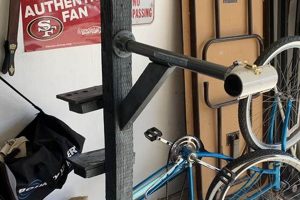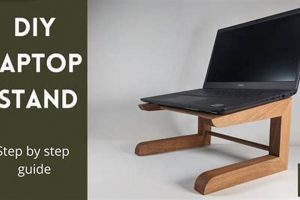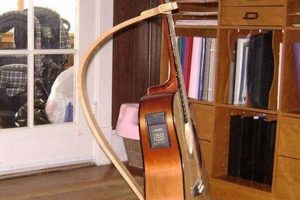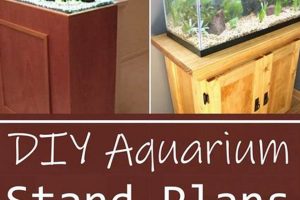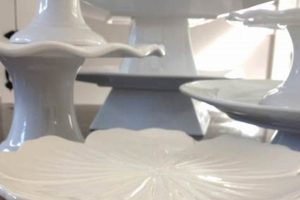A user-created, easily transportable platform designed to support a miter saw. These vary widely in construction, from simple wooden frames to more complex designs incorporating features like folding legs, integrated material supports, and even wheels for enhanced mobility. This type of stand represents an alternative to commercially manufactured options.
The creation of these stands offers several advantages. It can be a cost-effective solution for woodworkers, allowing them to utilize readily available materials and tailor the design to their specific needs and preferences. Furthermore, constructing a suitable platform enables increased job site efficiency through improved portability, setup time, and workspace organization. Historically, craftsmen have always adapted their workspaces to improve efficiency and portability, and this method is a contemporary example of that tradition.
The subsequent sections will detail various design considerations, material selection processes, and common construction techniques involved in creating functional and durable versions of these supports. Factors such as stability, weight capacity, and ease of transport will be addressed to provide a comprehensive understanding of the project.
Construction Strategies for Enhanced Stability
The following provides practical advice for individuals undertaking the construction of a user-created, transportable platform for a miter saw. Adherence to these strategies will contribute to a safer and more efficient work environment.
Tip 1: Material Selection: Prioritize dense hardwoods like maple or oak for primary structural components. These offer superior resistance to warping and deflection under load compared to softwoods.
Tip 2: Joint Reinforcement: Employ mechanical fasteners (screws, bolts) in conjunction with adhesive for all structural joints. This ensures long-term rigidity and prevents joint failure under repeated use and transport.
Tip 3: Leg Bracing: Implement diagonal bracing between the legs. This significantly increases the stand’s resistance to lateral movement and tipping, particularly on uneven surfaces.
Tip 4: Work Surface Dimensions: Ensure the work surface is adequately sized to support the workpiece. Overhanging material can create instability and increase the risk of accidents.
Tip 5: Weight Distribution: Design the support structure to evenly distribute the weight of the saw and workpiece. Concentrated loads can compromise stability and lead to premature failure.
Tip 6: Folding Mechanism Integrity: If the design incorporates a folding mechanism, utilize robust hinges and locking mechanisms. Regularly inspect these components for wear or damage.
Tip 7: Portability Considerations: Integrate durable handles or wheels for ease of transport. Consider the overall weight and dimensions of the stand when folded for convenient storage.
Implementing these strategies will contribute to a stable and reliable platform, minimizing the risk of accidents and improving the overall efficiency of woodworking tasks. Careful planning and execution are crucial for achieving a safe and functional outcome.
The subsequent section will address safety considerations for using a user-created miter saw support.
1. Material Strength
Material strength is a foundational determinant in the performance and safety of a user-created, transportable platform designed for a miter saw. The inherent capacity of the selected materials to withstand applied forces directly impacts the structural integrity and stability of the stand. Insufficient material strength can lead to deflection, cracking, or complete failure under the combined weight of the saw and workpiece, potentially causing injury or damage. For instance, using low-grade pine for the primary support structure of a heavy-duty miter saw is demonstrably inadequate due to its limited load-bearing capacity, whereas a frame constructed from steel tubing or dense hardwood exhibits significantly greater resistance to deformation and failure. Therefore, the specification of appropriate materials is not merely a cosmetic consideration but a critical engineering factor.
The choice of materials also influences the longevity and maintainability of the platform. A stand constructed from weather-resistant materials, such as pressure-treated lumber or powder-coated steel, will withstand environmental exposure better than one made from untreated wood, reducing the need for frequent repairs or replacements. Furthermore, the selected materials affect the overall weight of the stand, which in turn impacts its portability. A heavy-duty steel frame, while offering superior strength, may be less practical for transport than a lighter aluminum or composite structure. Therefore, material selection involves a trade-off between strength, durability, weight, and cost, requiring a careful analysis of the intended use and environmental conditions.
In conclusion, material strength is inextricably linked to the safety, stability, durability, and portability of a user-created, transportable miter saw support. Ignoring this fundamental principle can lead to structural failure and potential hazards. A thorough understanding of material properties and their suitability for the intended application is paramount to the successful design and construction of a reliable and effective support system. Furthermore, the material selected sets the stage for all other steps in the making of a “diy portable miter saw stand”.
2. Joint Integrity
Joint integrity is a crucial attribute in the construction of a user-created, transportable platform for a miter saw. The structural soundness of any such stand is directly proportional to the quality and strength of its joints. Inadequate joint construction can lead to instability, premature failure, and potential safety hazards during operation. For example, a stand with poorly constructed joints may wobble under the weight of the miter saw and workpiece, compromising accuracy and increasing the risk of kickback or other accidents. This attribute ensures long-term reliability and safety.
The selection of appropriate jointing techniques and materials is paramount. Simple butt joints, for instance, provide minimal strength and are generally unsuitable for load-bearing applications. More robust options, such as mortise and tenon, dovetail, or reinforced miter joints, offer significantly greater resistance to shear and tensile forces. Additionally, the use of high-quality adhesives and mechanical fasteners (screws, bolts) further enhances joint strength and durability. The impact of proper joint construction extends beyond the immediate stability of the stand; it also affects its resistance to repeated loading, vibration during use, and stresses induced during transport. A well-engineered joint will maintain its integrity over time, ensuring the stand remains a safe and reliable tool in diverse working conditions.
In summary, joint integrity is an indispensable component of a sturdy and dependable platform for a miter saw. Compromising on joint quality undermines the overall structural integrity, jeopardizes operator safety, and diminishes the service life of the stand. Therefore, meticulous attention to joint design and execution is essential for any individual undertaking the construction of a durable and safe support structure. This becomes particularly important when considering the transportable aspect of the project. Joints need to be sturdy enough to not break apart during transport.
3. Leg Stability
Leg stability represents a critical factor in the design and functionality of a user-created, transportable platform for a miter saw. The stability of the legs directly influences the safety and accuracy of cuts performed using the miter saw, as any instability can lead to imprecise cuts, material wastage, and potential hazards. The following points detail key facets of leg stability in this context.
- Footprint Size and Geometry
The area covered by the legs on the ground, and the geometric arrangement of those legs, profoundly impact stability. A wider footprint generally provides greater resistance to tipping. For example, legs splayed outwards at an angle offer more stability than legs positioned directly vertically. A rectangular footprint may provide directional stability, while a square footprint provides equal stability in all directions. Insufficient footprint area increases the risk of the platform tipping, especially when supporting heavy materials or during aggressive cutting operations. Calculations of the center of gravity combined with the support polygon created by the legs is a core consideration.
- Material Rigidity and Construction
The materials used for the legs, and their construction, are paramount. Sturdy materials like hardwood or steel resist bending and buckling under load. Solid construction techniques, such as mortise and tenon joints or welded connections, enhance the overall rigidity of the leg structure. Flexible or poorly joined legs will compromise stability, allowing the platform to sway or vibrate, affecting cutting precision and safety. Adding cross bracing to the legs is one method to improve the rigidity of the structure as a whole.
- Locking Mechanisms and Adjustability
For portable platforms, legs are often designed to fold or retract for easy transport and storage. Reliable locking mechanisms are essential to ensure the legs remain securely in the extended position during use. Adjustable legs allow the platform to be leveled on uneven surfaces, maintaining stability even on job sites with variable terrain. The absence of secure locking mechanisms or adjustability diminishes stability and introduces potential hazards.
- Load Capacity and Weight Distribution
The legs must be engineered to support the combined weight of the miter saw, the workpiece, and any applied forces during cutting. The design should distribute the weight evenly across all legs to prevent localized stress and potential failure. Exceeding the load capacity of the legs or uneven weight distribution can lead to instability and collapse. Attention to weight distribution is particularly important for portability.
These facets of leg stability are crucial considerations in the design and construction of a transportable miter saw platform. Neglecting any of these aspects can compromise safety, reduce cutting accuracy, and shorten the lifespan of the stand. A well-designed platform prioritizes leg stability to provide a safe, reliable, and efficient work surface for miter saw operations. The above points help clarify “diy portable miter saw stand” and its functionality, so that it might be built correctly.
4. Surface Area
Surface area, in the context of a user-created, transportable platform designed for a miter saw, directly affects the support offered to workpieces, influencing both safety and precision. The dimensions of the supporting surface dictate the range and type of projects that can be safely and effectively executed.
- Workpiece Support and Stability
A larger surface area provides enhanced support for longer or wider workpieces. This reduces the risk of material sagging or tipping during cutting operations. A demonstration would involve comparing a narrow stand that can only effectively support short pieces of trim versus a wider platform capable of handling full-sized lumber. Insufficient surface area necessitates additional support mechanisms, potentially increasing setup time and complexity.
- Material Handling and Organization
Adequate surface area allows for the organization and staging of materials during a project. This can streamline workflow and minimize the need for repeated trips to fetch materials. For instance, a wider platform could accommodate cut pieces on one side and uncut stock on the other, improving efficiency. Limited surface area requires more frequent handling of materials, increasing the potential for errors or accidents.
- Integration of Accessories and Features
A larger surface area facilitates the integration of accessories such as material supports, measuring scales, or dust collection systems. These additions can enhance the functionality and convenience of the platform. As an example, a wider platform might incorporate retractable material supports that extend beyond the edges of the saw, providing added stability for long boards. Insufficient surface area restricts the ability to add these features, limiting the platform’s versatility.
- Portability Trade-offs
While a larger surface area offers benefits in terms of support and functionality, it also increases the overall size and weight of the platform, potentially affecting its portability. A balance must be struck between surface area and ease of transport, depending on the intended use and storage constraints. A folding platform with a moderate surface area might be more practical for frequent transport than a larger, non-folding design.
The optimization of surface area is essential in the development of an effective and user-friendly platform. It involves considering the typical size of workpieces, the need for material organization, the potential for accessory integration, and the constraints of portability. A well-designed platform strikes a balance between these factors, providing a functional and efficient work surface for a variety of miter saw operations. Thus, surface area is a leading consideration when starting your “diy portable miter saw stand” project.
5. Portability Design
Portability design, in the context of a user-created, transportable platform for a miter saw, is not merely an aesthetic consideration but a critical functional requirement that directly impacts the utility and practicality of the stand. The ability to readily move and transport the platform is a primary motivator for its construction in the first place, distinguishing it from stationary, shop-based alternatives. Without careful attention to portability design, the platform’s intended purpose is fundamentally compromised.
Effective portability design necessitates a multifaceted approach, encompassing weight management, folding or disassembly mechanisms, integrated handles or wheels, and overall dimensional optimization. For example, a platform constructed from heavy-gauge steel, while robust, may be impractical for frequent transport due to its excessive weight. Conversely, a platform with an intricate folding mechanism may be lightweight but prone to failure under repeated use. Successful designs prioritize a balance between strength, durability, and portability. Consider a platform featuring a tubular steel frame with strategically placed hinges, allowing it to fold into a compact form factor for storage and transport, coupled with integrated wheels for ease of movement across job sites. This balance is critical, especially for mobile tradespeople who frequently change work locations. The use of lightweight materials, such as aluminum, also provides considerable weight savings, which can result in increased transportation options. Without this attribute, the “diy portable miter saw stand” project will lack the main characteristics of this project.
In summary, portability design is an indispensable element of a functional and effective platform for a miter saw. It dictates the ease with which the stand can be moved, stored, and deployed in diverse working environments. A well-executed design maximizes portability without sacrificing strength, stability, or durability, enhancing the overall utility and practicality of the platform. Neglecting this crucial aspect can render the platform cumbersome and impractical, negating the primary benefits of a user-created, transportable solution. Overlooking this crucial design point can cause a failure of the project and the project might not live as expected.
Frequently Asked Questions
The following addresses common inquiries and misconceptions regarding the design, construction, and utilization of user-created, transportable platforms designed for miter saws. These answers are intended to provide clarity and guidance for individuals considering undertaking such a project.
Question 1: What is the minimum acceptable weight capacity for such a platform?
The minimum acceptable weight capacity is contingent upon the weight of the miter saw and the typical weight of the workpieces to be supported. A safety margin of at least 25% beyond the maximum anticipated load is recommended to accommodate dynamic forces and prevent structural failure. Consult the miter saw’s documentation for its weight specification.
Question 2: What are the most common causes of instability in user-created platforms?
Common causes of instability include inadequate leg bracing, insufficient footprint, use of flexible materials, and poorly constructed joints. Uneven weight distribution and operation on uneven surfaces also contribute to instability. Addressing these factors through careful design and construction is crucial for safety.
Question 3: Are there specific dimensional guidelines for the platform surface area?
Specific dimensional guidelines depend on the typical workpiece size. The platform surface should extend beyond the saw’s cutting range to provide adequate support. A minimum width of 18 inches is generally recommended, with the length determined by the most common workpiece length.
Question 4: What are the most durable materials for constructing a transportable platform?
Durable materials include hardwoods such as oak or maple for structural components, and steel or aluminum for framing and legs. Pressure-treated lumber can be used for outdoor applications, but it should be properly sealed to prevent warping. Avoid using brittle plastics or thin-gauge metals in load-bearing areas.
Question 5: How can portability be optimized without compromising stability?
Portability can be optimized through the use of lightweight materials, folding or collapsible designs, and integrated wheels or handles. However, these features should not compromise stability. Robust locking mechanisms and secure leg bracing are essential to maintain stability when the platform is in use.
Question 6: What safety precautions should be observed when using a user-created transportable platform?
Safety precautions include ensuring the platform is level and stable before operation, wearing appropriate personal protective equipment (eye protection, hearing protection), securing the workpiece to the platform, and keeping the work area clear of obstructions. Regularly inspect the platform for signs of wear or damage, and promptly repair or replace any compromised components.
In summary, the construction and utilization of user-created transportable miter saw platforms require careful attention to design, material selection, and safety considerations. Adherence to sound engineering principles and best practices is essential for ensuring a safe and effective work environment.
The next section will explore advanced techniques for customizing these platforms.
DIY Portable Miter Saw Stand
The preceding analysis elucidates the multifaceted considerations inherent in the design and construction of a user-created, transportable platform for a miter saw. Material strength, joint integrity, leg stability, surface area, and portability design represent interdependent variables that collectively determine the functionality, safety, and longevity of such a structure. A comprehensive understanding of these principles is paramount for any individual embarking on such a project. A failure to adequately address any of these factors will ultimately compromise the utility and safety of the final product.
The creation of a “diy portable miter saw stand” presents both opportunities and challenges. While it offers the potential for cost savings and customization, it also demands a commitment to sound engineering practices and rigorous attention to detail. A successful outcome requires not only technical skill but also a deep understanding of the forces at play and the potential risks involved. Individuals considering such a project should approach it with a discerning eye, a commitment to safety, and a willingness to invest the time and effort necessary to achieve a result that is both functional and reliable. Safety, specifically, is a leading consideration that should not be overlooked.


